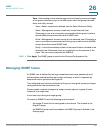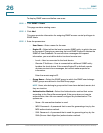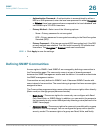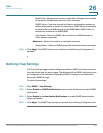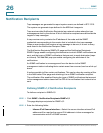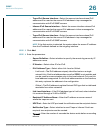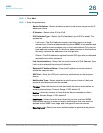
SNMP
Notification Recipients
Cisco Small Business 200, 300 and 500 Series Managed Switch Administration Guide (Internal Version) 536
26
• Traps IPv4 Source Interface—Select the source interface whose IPv6
address will be used as the source IPv6 address in trap messages for
communication with IPv6 SNMP servers.
• Informs IPv6 Source Interface—Select the source interface whose IPv4
address will be used as the source IPv4 address in inform messages for
communication with IPv4 SNMP servers.
• Traps IPv6 Source Interface—Select the source interface whose IPv6
address will be used as the source IPv6 address in trap messages for
communication with IPv6 SNMP servers.
NOTE If the Auto option is selected, the system takes the source IP address
from the IP address defined on the outgoing interface.
STEP 3 Click Add.
STEP 4 Enter the parameters.
• Server Definition—Select whether to specify the remote log server by IP
address or name.
• IP Version—Select either IPv4 or IPv6.
• IPv6 Address Type—Select either Link Local or Global.
- Link Local—The IPv6 address uniquely identifies hosts on a single
network link. A link local address has a prefix of FE80, is not routable, and
can be used for communication only on the local network. Only one link
local address is supported. If a link local address exists on the interface,
this entry replaces the address in the configuration.
- Global—The IPv6 address is a global Unicast IPV6 type that is visible and
reachable from other networks.
• Link Local Interface—If the IPv6 address type is Link Local, select whether
it is received through a VLAN or ISATAP.
• Recipient IP Address/Name—Enter the IP address or server name of
where the traps are sent.
• UDP Port—Enter the UDP port used for notifications on the recipient device.
• Notification Type—Select whether to send Traps or Informs. If both are
required, two recipients must be created.
• Timeout—Enter the number of seconds the device waits before re-sending
informs.





